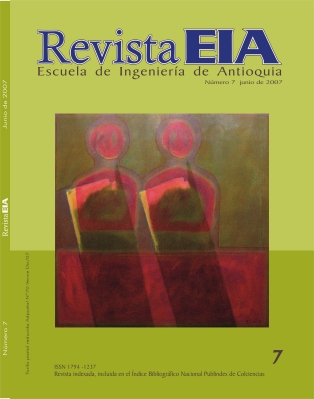FABRICACIÓN Y CARACTERIZACIÓN DE UNA MATRIZ TRIDIMENSIONAL DE HIDROXIAPATITA MACROPOROSA PARA APLICACIÓN EN INGENIERÍA DE TEJIDOS ÓSEOS
FABRICACIÓN Y CARACTERIZACIÓN DE UNA MATRIZ TRIDIMENSIONAL DE HIDROXIAPATITA MACROPOROSA PARA APLICACIÓN EN INGENIERÍA DE TEJIDOS ÓSEOS


Esta obra está bajo una licencia internacional Creative Commons Atribución-NoComercial-SinDerivadas 4.0.
Declaración del copyright
Los autores ceden en exclusiva a la Universidad EIA, con facultad de cesión a terceros, todos los derechos de explotación que deriven de los trabajos que sean aceptados para su publicación en la Revista EIA, así como en cualquier producto derivados de la misma y, en particular, los de reproducción, distribución, comunicación pública (incluida la puesta a disposición interactiva) y transformación (incluidas la adaptación, la modificación y, en su caso, la traducción), para todas las modalidades de explotación (a título enunciativo y no limitativo: en formato papel, electrónico, on-line, soporte informático o audiovisual, así como en cualquier otro formato, incluso con finalidad promocional o publicitaria y/o para la realización de productos derivados), para un ámbito territorial mundial y para toda la duración legal de los derechos prevista en el vigente texto difundido de la Ley de Propiedad Intelectual. Esta cesión la realizarán los autores sin derecho a ningún tipo de remuneración o indemnización.
La autorización conferida a la Revista EIA estará vigente a partir de la fecha en que se incluye en el volumen y número respectivo en el Sistema Open Journal Systems de la Revista EIA, así como en las diferentes bases e índices de datos en que se encuentra indexada la publicación.
Todos los contenidos de la Revista EIA, están publicados bajo la Licencia Creative Commons Atribución-NoComercial-NoDerivativa 4.0 Internacional
Mostrar biografía de los autores
La ingeniería de tejido óseo surge como una nueva opción para el tratamiento de muchos tipos de afecciones, entre ellas las enfermedades óseas, permitiendo resolver múltiples problemas en el área médica. El desarrollo de una matriz de hidroxiapatita para cultivo de células óseas permitirá contar con otra alternativa para enfrentar las enfermedades causadas en el hueso y articulaciones que frecuentemente llevan a la discapacidad en las personas. En este trabajo se obtuvo hidroxiapatita sintética por la ruta de precipitación a partir de fosfato de amonio NH4H2PO4 y nitrato de calcio Ca(NO3)2.4H2O. Se formaron matrices en las cuales se indujo macroporosidad con el agente natural Zea mays, con partículas entre 350 µm y 600 µm, y microporosidad con celulosa en proporciones peso/peso de 4% y 8%. Las muestras fueron caracterizadas con pruebas de compresión, microscopía electrónica de barrido (SEM), que incluyó espectroscopia por dispersión de energía de rayos X (EDS) y difracción de rayos X (DRX). Se obtuvieron matrices macroporosas de hidroxiapatita cristalina con un diámetro de poro entre 300 µm y 500 µm en promedio, con porosidades entre 35,85% y 45,61%, densidades en el rango de 1,48-1,77 g/cm3 y relación Ca/P de 1,7. Para los bloques con 4% de agente microporoso la resistencia a la compresión fue de 1,06 MPa y el módulo de elasticidad, de 67,15 MPa. Los bloques con 8% tuvieron una resistencia a la compresión de 1,08 MPa y un módulo de elasticidad de 54,65 MPa.
Abstract: Bone tissue engineering came up as a new option treatment for different kinds of illness, among them bone diseases. All this development has allowed solving multiple medical problems. The development of a hydroxyapatite scaffold for bone cells culture will be another alternative to attend several diseases that are caused on bones and that usually lead to disabilities in people. In this study synthetic hydroxyapatite was produced by a precipitation route with amonium phosphate (NH4H2PO4) and calcium nitrate (Ca(NO3)2*4H2O) as precursors. Scaffolds were manually molded, and macroporosity was induced with a natural agent, named Zea mays, with a particle size ranging between 350 µm and 600 µm. Microporosity was induced using cellulose with proportions of 4% and 8% (weight/weight). The samples were characterized by compression test, scanning electronic microscopy (SEM), energy dispersive spectroscopy (EDS), and X ray diffraction (XRD). Crystalline hydroxyapatite scaffolds were obtained and they presented an average pore diameter between 300 µm and 500 µm, porosities between 35,85% and 45,61%, densities in the range of 1,48-1,77 g/cm3 and Ca/P ratio of 1,7. The calculated compressive strength for the 4% of microporous block was 1,06 MPa and the elastic modulus was 67,15 MPa; while the 8% microporous blocks showed a strength of 1,08 MPa and an elastic modulus of 54,65 MPa.
Visitas del artículo 288 | Visitas PDF 285
